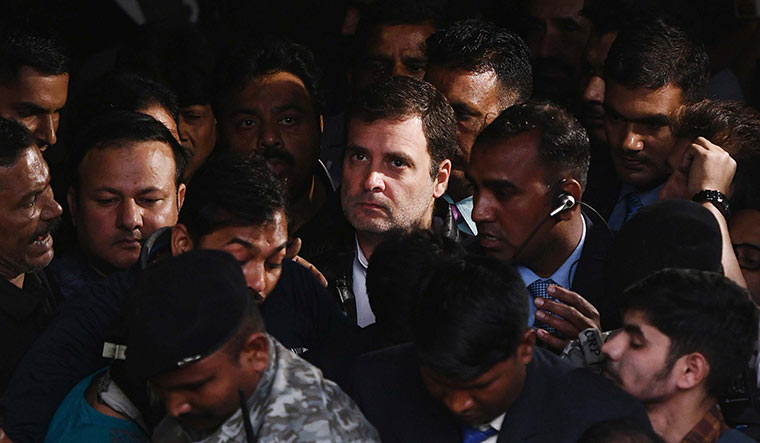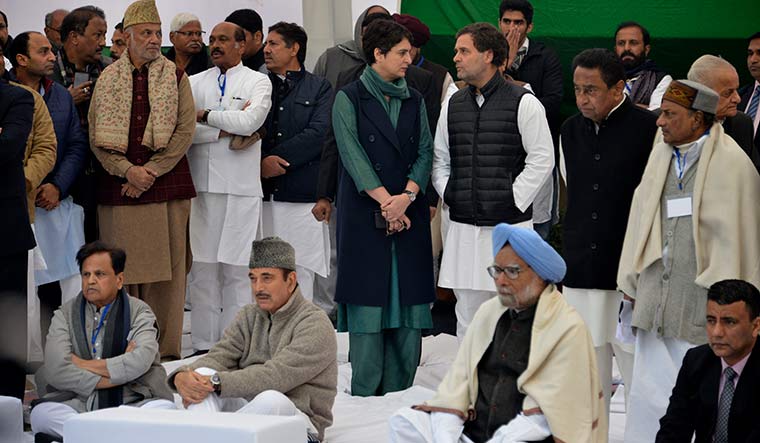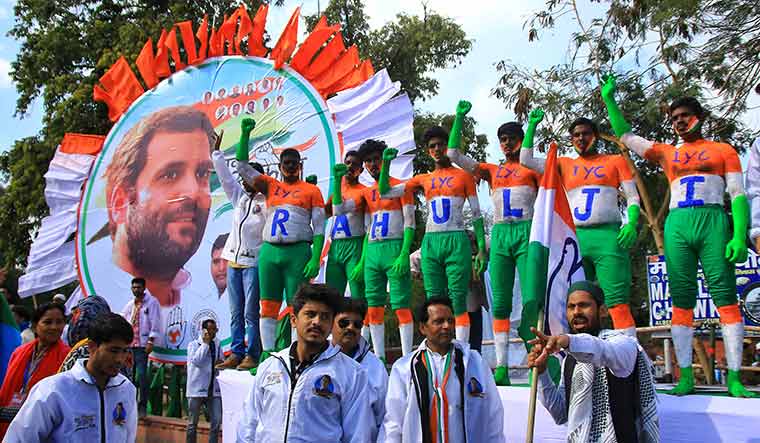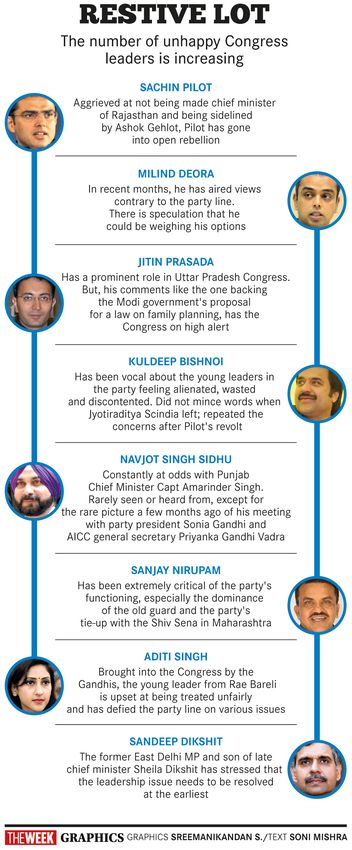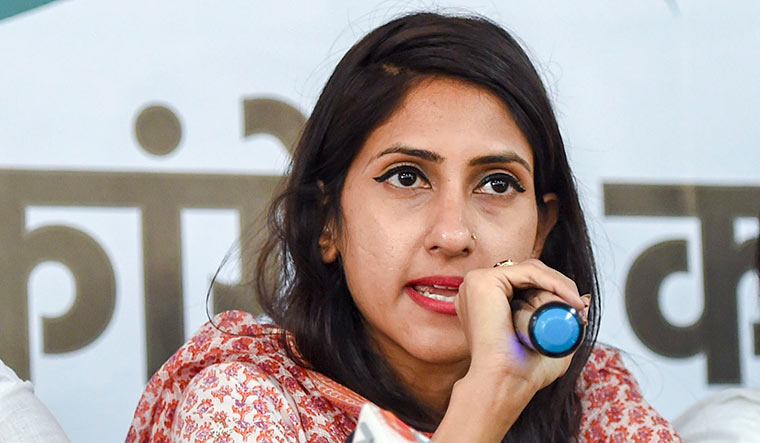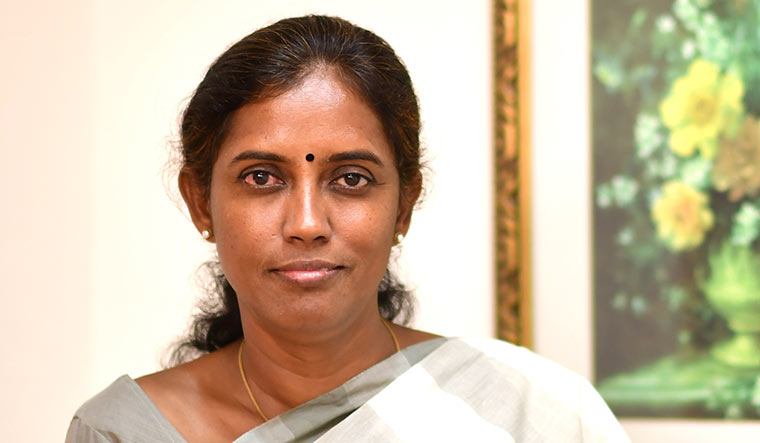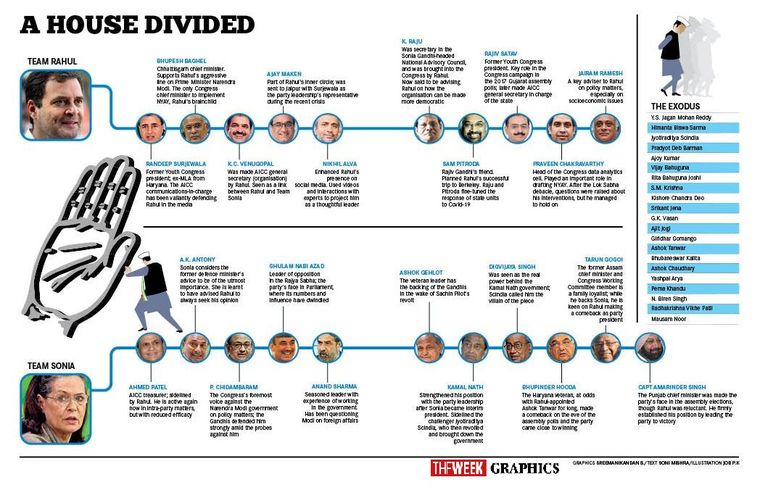Whether you like him or not, you have to admire Rahul Gandhi for his gumption to walk back into the limelight despite the crushing electoral defeats, the myriad questions raised about his leadership abilities and the ignominy of being held up as an object of ridicule by his political rivals.
In the midst of Covid-19, the former Congress president has taken a new avatar and is tirelessly carrying out an incessant critique of the Narendra Modi government’s handling of the pandemic, the economy and the Chinese intrusions in Ladakh.
There is a hectic pace to Rahul’s online interventions, and his effort is to project the Modi government as incapable of handling the pandemic and the economic slowdown, and as dishonest on the skirmish with China.
It, however, appears that the main purpose of the endeavour is to refurbish Rahul’s image and project him as a person who delves into issues with the rigour of an intellectual and the sensitivity of an empathetic, thoughtful leader.
The image revamp coincides with the Gandhi scion crossing an important milestone—he turned 50 this year. He cannot be referred to as a young leader anymore, having well and truly entered middle age.
In keeping with the seniority that he has assumed, he has given up the belligerence of the angry young leader persona of yore, appearing calm, composed, thoughtful and self-assured in his online outings.
Clean-shaven, hair neatly combed, the kurta replaced by a formal blue shirt in his videos on the Chinese incursions, the get-up seems aimed at showing him as a leader with a difference. The tone, too, is markedly different, shorn of the aggression of the ‘chowkidar chor hai’ slogan.
Rahul has said he wanted to offer constructive criticism over how the government was managing Covid-19 and its impact on the economy. He has had a series of online conversations with experts such as Raghuram Rajan, Abhijit Banerjee, Ashish Jha, Rajiv Bajaj and Muhammad Yunus on the socio-economic effects of the pandemic. He sat down on a footpath with a group of migrant workers to talk about their struggles and interacted with a taxi driver at a tea stall, the events gaining traction on social media.
He has held news conferences, posted video messages, has been active on Twitter and has even launched his Telegram channel. And the latest online tranche of four slickly produced videos on the Chinese incursions attempts to show him as a leader with a deep insight into the problem, thereby trying to project Modi, by comparison, as not telling the complete truth about the issues with China.
A repackaging of Rahul is under way, and the effort appears to be to project him as the antithesis of Modi, as a leader who is empathetic to the vulnerable sections of society, willing to seek suggestions from experts and is prepared to take questions from the media. He has sought to come across as the voice of sanity in these uncertain times.
While Rahul was not altogether missing from the public eye after his resignation last year, he did stay under the radar, hence there is intense speculation whether he is now ready to make a comeback as Congress president.
The timing of Rahul’s efforts makes it all the more interesting. His mother, Sonia Gandhi, who stepped in after his resignation, completes one year as interim chief of the Congress on August 10. With no sign of a process being put in place to elect a new president, an option before the party is to extend Sonia’s interim presidentship. The other possibility is Rahul agreeing to take charge and settling the leadership issue.
At a news conference a couple of months ago, Rahul was asked whether he was on a comeback trail. He replied: “Please see my letter from a year ago…. I stand by my letter.” Sources close to him said the reasons why he quit were spelt out clearly in his open letter issued at the time of his resignation and that it stressed that accountability needed to be fixed at all levels. They said he would come back on his own terms.
A close Rahul aide said his return as Congress president was imminent, although he could not confirm whether it would happen now. “Majority of the Congress workers definitely want him back. It is also a fact that Sonia Gandhi’s appointment was on a temporary basis, with a certain date, which we are now nearing. There are serious health issues. She stepped in to fill a vacuum, and she cannot continue doing that indefinitely. So I am sure there will be a resolution soon, though I am not sure what that resolution will be,” he said.
Rahul’s supporters have begun calling for his return. Demands were made in the Congress working committee (CWC) meeting of June 23 and Sonia’s meetings with party MPs on July 11 and July 30. Rahul’s staunch supporters, who had defended his decision to resign, now want him to come back.
“As someone who worked with him, I was not disappointed with his decision to resign as party president. The party lost the Lok Sabha election. But it was not his fault alone. Yet, he came forward to put in his papers. But now, I feel it is high time he returned as party president,” said S. Jothimani, MP from Karur and a close aide of Rahul.
Along with the demand for Rahul’s return, the divide between the old guard and the young leaders in the party—the principal reason for his resignation—has reappeared, too. It played out in Sonia’s meeting with members of the Rajya Sabha on July 30. The leaders in this meeting, many of them representing the old guard, were not so effusive in their demand that Rahul come back, quite unlike the fervent demand heard in her meeting with Lok Sabha members on July 11.
The meeting, in fact, became a war of words between the seniors and the young leaders identified as Team Rahul. The call for introspection made by senior leaders and the organisational issues raised by them were seen by Rahul’s supporters as expressing reservations about his leadership. Rahul aide Rajiv Satav reportedly said the introspection had to begin with the functioning of the second United Progressive Alliance government and how the Congress fell from more than 200 seats in 2009 to just 44 in 2014. There was an immediate retort to this from leaders like Manish Tewari and Shashi Tharoor, who were ministers in the UPA government and are uncomfortable with the way the leadership issue has been dragging on.
The seniors are also said to be uncomfortable with Rahul’s online interactions, especially his China videos. They complain that he is setting a line of attack against the Modi government without consulting party leaders. It has been an old grouse that Rahul relies on his set of advisers rather than taking the senior leaders into confidence, betraying a distrust of them. Moreover, they feel he has been going on a trajectory of his own, without taking the party along or conveying the impression that the view that is being offered has been discussed and debated in the party.
In the past one year following Rahul’s resignation, several voices within the party have demanded an end to the leadership conundrum, arguing that it was hurting the party badly. The sentiment gathered steam after the party drew a blank in the assembly elections in Delhi, second time in a row, and leaders including Tewari, Tharoor, Abhishek Manu Singhvi and Sandeep Dikshit spoke about the need for Rahul to make it clear whether he wanted to be Congress president or not, so that the party could then go ahead and settle the issue. Some leaders suggested having a non-Gandhi at the helm, while some others felt that general secretary Priyanka Gandhi Vadra can step up, although she has made it clear that she wants to focus on Uttar Pradesh, her current assignment.
Gathering momentum is the view that either the CWC appoints a full-time president or elections be held for the top post as Sonia completes a year as interim chief. Many leaders feel that if Rahul does not want to come back as president, then the party should ideally have elections for the post.
There is restiveness in the party, even among Rahul’s supporters, over the way he has kept the leadership issue hanging, and it is felt that the uncertainty is doing the party a lot of harm. The state of drift, with the leadership vacuum not allowing the party to have a sense of direction, is proving to be a big impediment in countering the aggressive politics of the Modi-Shah combine. Electoral contests apart, the party has found it difficult to keep its flock together; its government in Madhya Pradesh fell a few months ago and its chief minister in Rajasthan, Ashok Gehlot, is struggling to save his government.
There is a growing feeling that the Congress has failed to stop its decline. Its national footprint has shrunk drastically, and its organisation has become weak and lacks direction. Leaders have deserted it in a steady stream, with a weak high command unable to negotiate with regional satraps from a position of power. And the party has been unable to get an ideological footing to take on the BJP-RSS.
Statistics bring out the current state of the Congress. It has just 92 MPs in parliament which has 790 members—52 in the Lok Sabha and 40 in the Rajya Sabha. It has about 800 MLAs of a total of 4,123 MLAs in the country. In the last Lok Sabha elections, it failed to win a single seat in 13 states and five Union territories. In the politically crucial Uttar Pradesh, it won only one seat—Sonia Gandhi’s Raebareli. The victory in the heartland states in the assembly polls in December 2018 failed to translate into any gains in the Lok Sabha elections.
The party which was in power in 14 states in 2014 now rules only three states—Rajasthan, Punjab and Chhattisgarh—and the Union territory of Puducherry, and is a junior partner in the government in Maharashtra and Jharkhand. There are vast expanses where the party has either become redundant or is riding on the back of a regional player. Madhya Pradesh was won back from the BJP after a gap of 15 years, but the Kamal Nath government fell because of desertions. The northeast, once the party’s stronghold, is now Congress-mukt.
“Not enough has been done at the state and Central levels to revamp the party. The party has to make a serious effort to train leaders and workers to make them understand the Congress ideology, the history of the party and the nation,” said former Madhya Pradesh chief minister Digvijaya Singh.
There is dissatisfaction with the manner in which the high command culture works and there are demands that decision making should involve diverse voices and must be decentralised. “Why can’t you have leaders who are in their 20s and 30s in the decision-making process? The party needs to hear new and diverse views,” said Aditi Singh, MLA from Raebareli, who was once close to the Gandhis, but is now seen as a rebel leader.
Former Assam chief minister Tarun Gogoi said the party should put in place a dedicated cadre like that of the RSS. “The workers should have a sense of commitment to the party ideology and be ready to fight and make sacrifices for it. We used to have committed leaders. But that is not the case now,” he said.
Ideological clarity is, however, what the party appears to lack at the moment. It looked confused in its responses to crucial issues such as abrogation of Article 370, the Citizenship (Amendment) Act and the National Register of Citizens. It could not take a clear stand on the construction of the Ram temple and on the tie-up with the ideologically opposite Shiv Sena. The party has found itself doing a tight-rope walk between its own ideological bases of secularism and inclusive politics, and the hindutva-based and nationalism-infused narrative of the BJP.
The Congress needs a powerful story of its own to counter the BJP’s narrative, and this has to be provided by the leadership. Rahul found a potent line of attack, unveiled in his Berkeley talk in 2018, but it was lost in the noise over nationalism in the post-Pulwama situation and in his own reliance on the ‘chowkidar chor hai’ election slogan.
Even as the party debates the efficacy of Rahul’s renewed attacks on the Modi government, his supporters insist he is on the right track. “Yes, he is a dynast. He has that baggage. But there is no denying that he has a unique voice and he speaks from the heart,” said a Rahul aide. “He is talking to an audience those in power do not care about. He is resonating, maybe not on a tsunami scale right now. Will that happen in the next two to three years, given the current state of affairs? I definitely think so.”
Rahul has complained that he finds himself alone in his fight against Modi. This is a point he stressed in his resignation letter and has repeated in party meetings. However, Randeep Surjewala, head of the Congress communications department, who is close to Rahul, said, “Rahul Gandhi has never said he is alone in the fight against Narendra Modi. He only expects every Congress leader, who has served in positions of power, to rise in unison in these difficult times to fight the battle unitedly and not be hesitant of the brutalities unleashed by the Modi government by false cases of ED or the Income Tax or the CBI. When he says ‘Daro mat’ (Don’t be afraid), which is his clarion call for all, he says it also to Congress leaders to be not scared of Modi.”
Members of Team Rahul have felt abandoned and sidelined after his resignation, and some of them felt compelled to leave the party, the most significant one being Jyotiraditya Scindia. Some others have been sulking or striking discordant notes, such as Milind Deora or Jitin Prasada. Sachin Pilot, another prominent young leader, has gone on the warpath against the leadership, leaving the Gehlot government in dire straits.
“There are problems in the Congress across the country and that is largely because there is no direction. Party leaders and workers don’t know where the buck stops or to whom to address their problems,” said Pradyot Deb Barman, who quit as Tripura state Congress president last year. “Circumstances in the party changed drastically after Rahul’s resignation. Young leaders like me were in the party because of him. But after his resignation, he became unresponsive to our concerns. He changed his number and it became impossible for us to get in touch with him,” Barman said.
As questions were raised about Rahul abandoning leaders who had grown in the party with him, some leaders said he had actually promoted ‘babalog’, who came from entitled backgrounds and could not deal with loss of power. Newly appointed Congress working president of Gujarat, Hardik Patel, said it was wrong to say that young leaders in the party were not getting their due. “Had that been the case, a 26-year-old like me would not have been given such an important assignment in a crucial state. While the party leadership recognised Sachin Pilot’s abilities, it also gave regard to the experience and political sagacity of Ashok Gehlot. Similarly, in Madhya Pradesh, it was felt that the experience of Kamal Nath was important to run the government. Young leaders need to exercise dhairya, dheeraj aur sahas (patience, endurance and courage),” he said.
Countering the criticism that Rahul left young leaders to fend for themselves or was inaccessible, Surjewala said, “Scindia and Pilot were treated by Rahul Gandhi as not just friends but as members of the family. So if either of them says they were unable to meet him, they are simply lying.”
Said Surjewala, “When you work in a political scheme of things, you have to negotiate the political waters without looking at Delhi 24x7 for intervention. So Scindia had to learn to negotiate the political waters alongside a Kamal Nath and a Divgijaya Singh or Pilot had to learn to deal with Gehlot. To expect Rahul Gandhi to be on their side 24x7, negotiating those political waters, would be too much to ask.”
Meanwhile, as friends turn foes, supporters get restless, detractors get into attack mode and the party withers, the time for Rahul to make up his mind is running out.
Give up the sycophantic culture
ADITI SINGH
MLA, Raebareli
After the 2019 Lok Sabha elections, Rahul Gandhi said there would not be another Gandhi at the helm of the Congress and that things needed to change. But the party went ahead and appointed Sonia Gandhi as interim president. Now we hear that Rahulji is poised to come back as president. So, is there any change happening? Leaders like Jyotiraditya Scindia and Sachin Pilot might have thrown their hats in the ring for the post of Congress president.
The youngest member in the Congress Working Committee is 37. Why cannot you have leaders who are in their 20s and 30s in the decision-making process? For me, what has been most frustrating is that things just do not seem to move in the party. Nothing happens, no new thing gets done.
Twitter trolls call me opportunistic. But I joined the Congress in 2016 when it was not in power at the Centre and was not in a position to win in Uttar Pradesh. I joined the party because I had faith in the party’s ideology. But now I do not think there is any ideology left.
I think India deserves a better opposition. The party needs to get rid of the ‘chamchagiri (sycophancy)’ culture. It needs an active leadership and inner-party democracy. We have brilliant leaders in the party. But if you do not know how to make use of them, then nobody can help you.
Congress is not a bunch of sycophants
S. JOTHIMANI
MP, Karur
Rahul Gandhi is the best thing that has happened to the Congress. I am not saying this because he is my leader and my mentor, but because of the qualities that he embodies. A leader has to be committed, honest, truthful, knowledgeable, visionary, democratic and compassionate. Rahul is upfront, speaks the truth irrespective of the consequences and he understands the idea of India. He empowered young leadership and tried to build a party with all kinds of leaders.
We are not a bunch of sycophants. We have strong views. We have many differences with Rahul. But we trust the Gandhi family and his leadership because of what they stand for.
Rahul said he himself was the symptom of a disease called nepotism. He fought against the status quo. That is why he is what he is now. He could have been prime minister in 2009 itself. But he is not after power. When the Congress was in power, he moulded leaders like me.
I was not disappointed with his decision to resign as party president. The party lost the Lok Sabha elections. It was not his fault alone. Yet, he put in his papers. Now I feel it is high time he returned as party president. He should build the Congress and its organisation from the grassroots. The clarity that he has for fighting the RSS and the anti-people regime of the BJP has to percolate down through the party.


